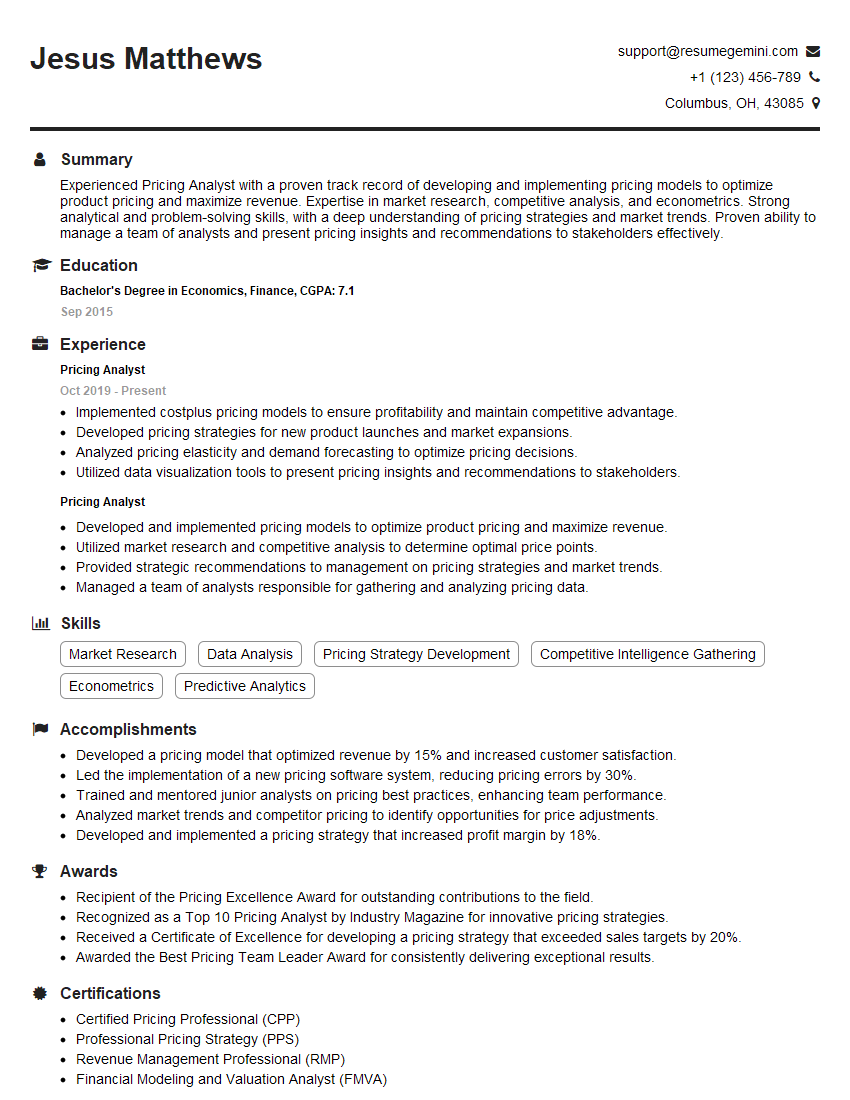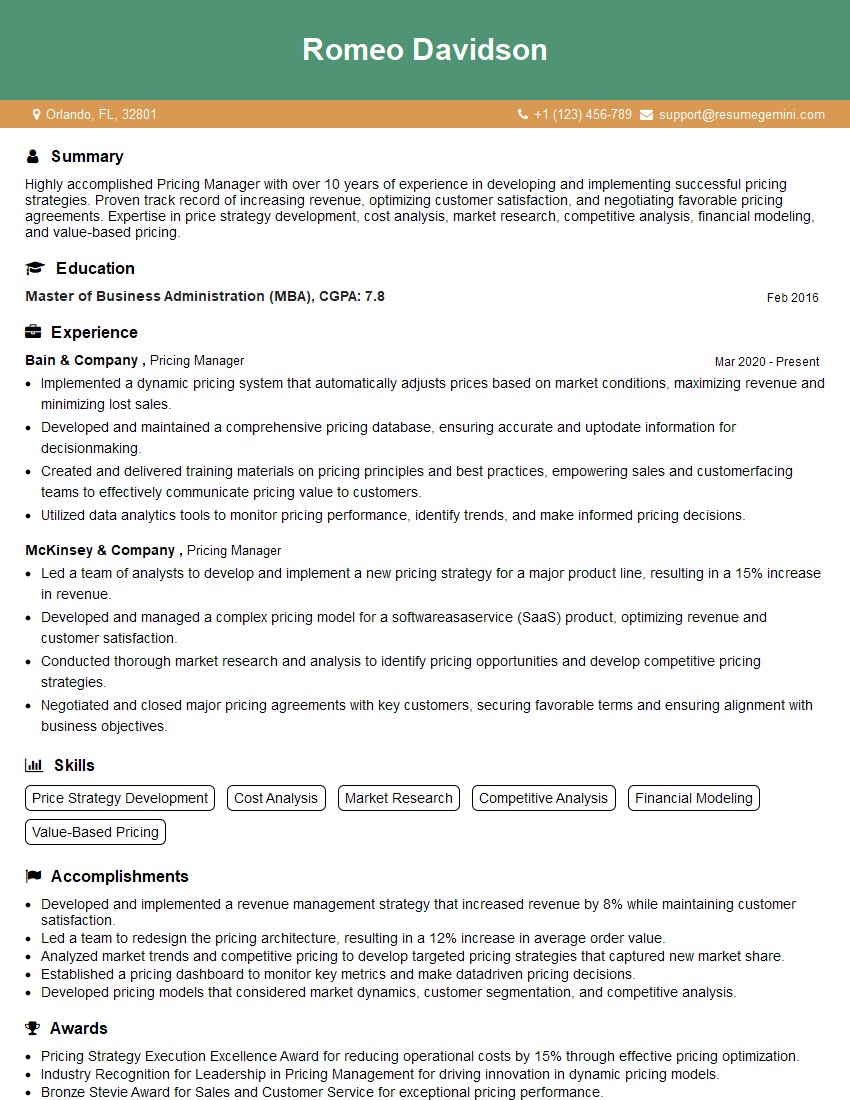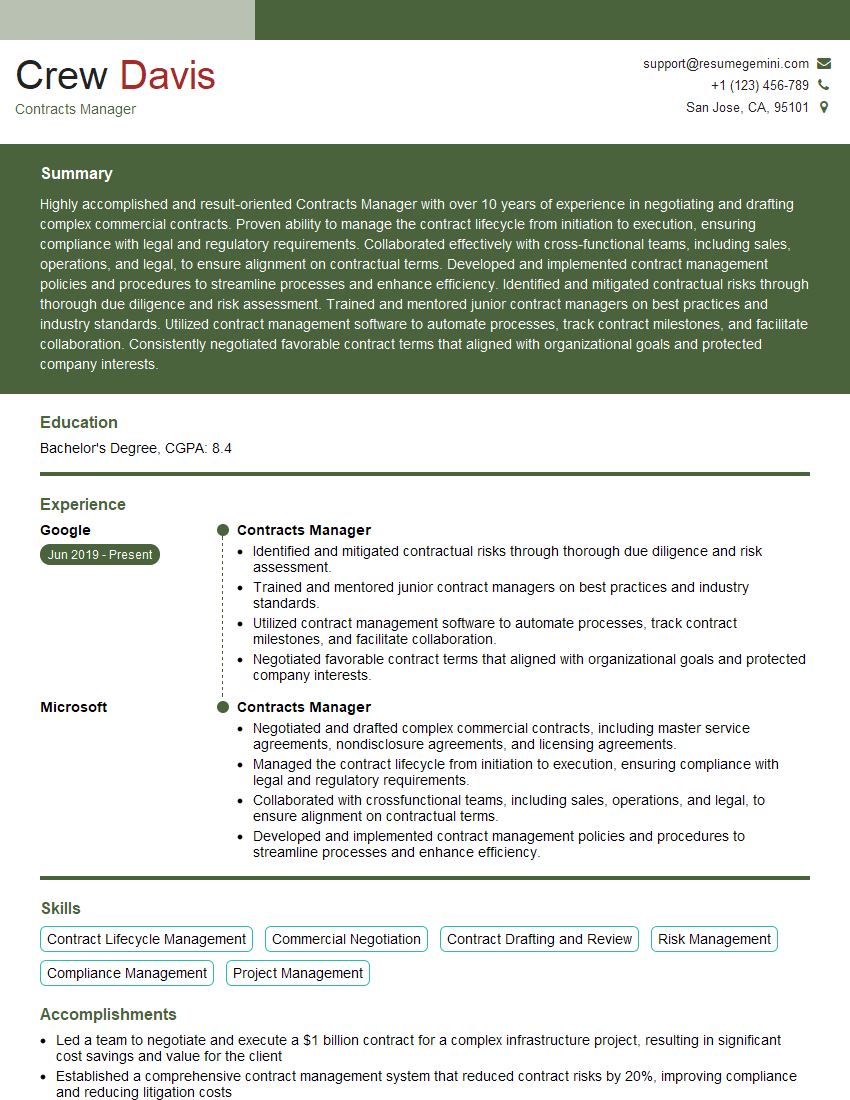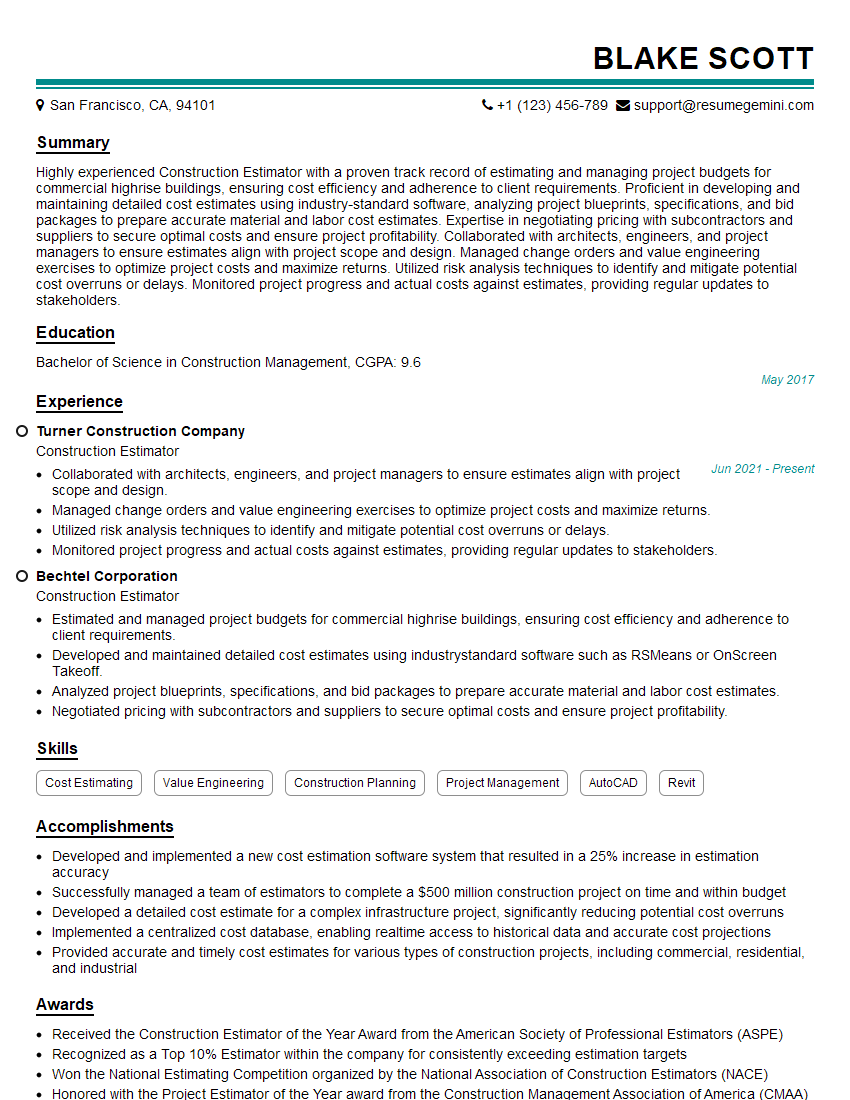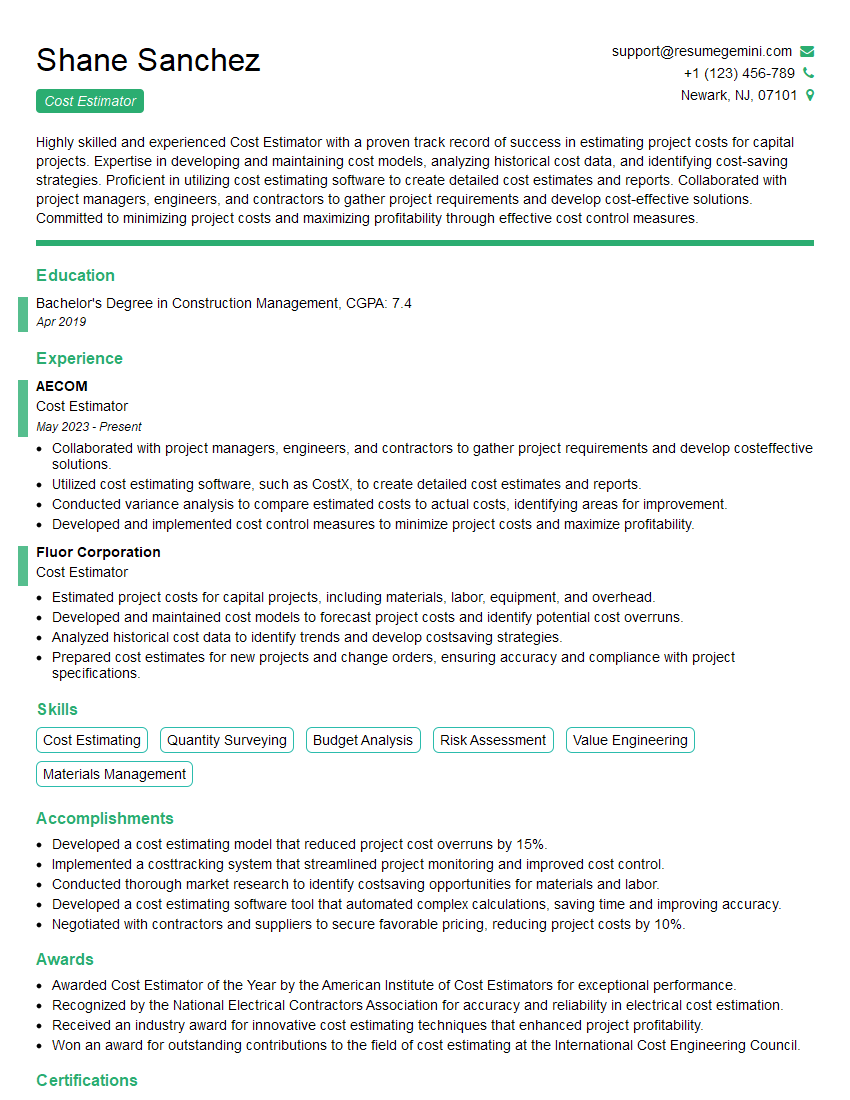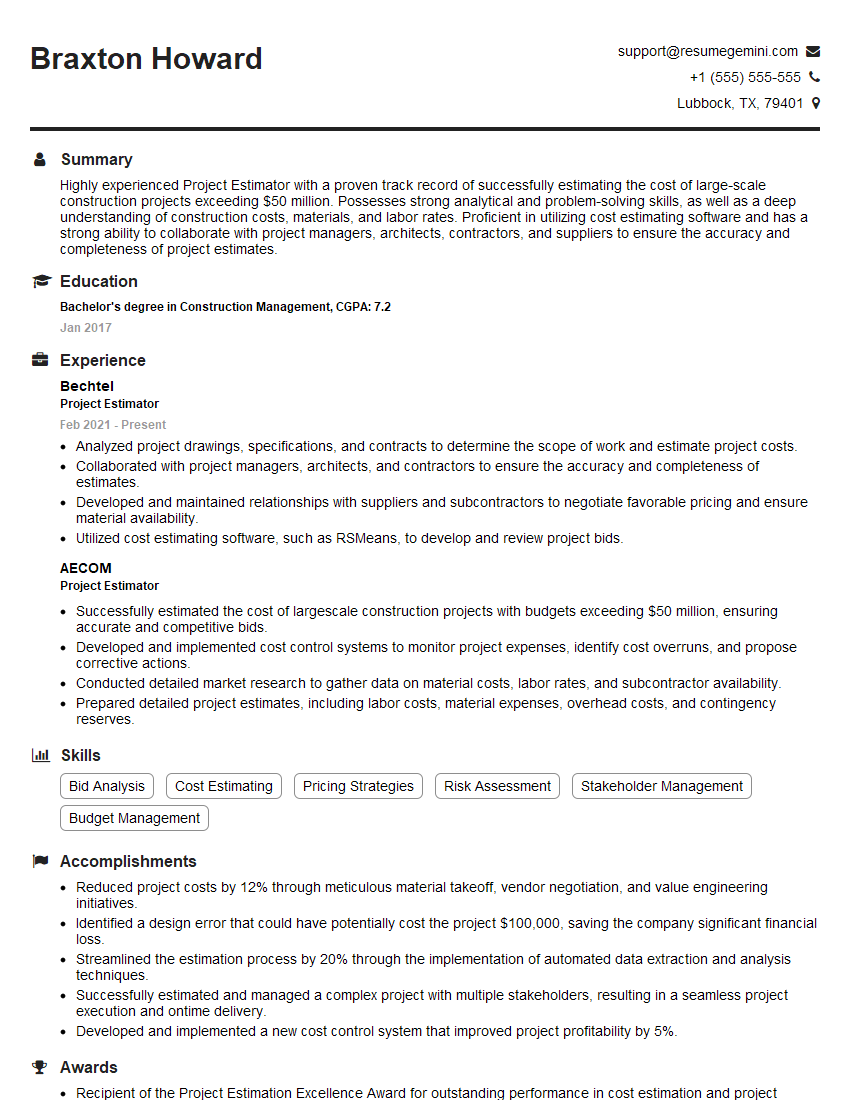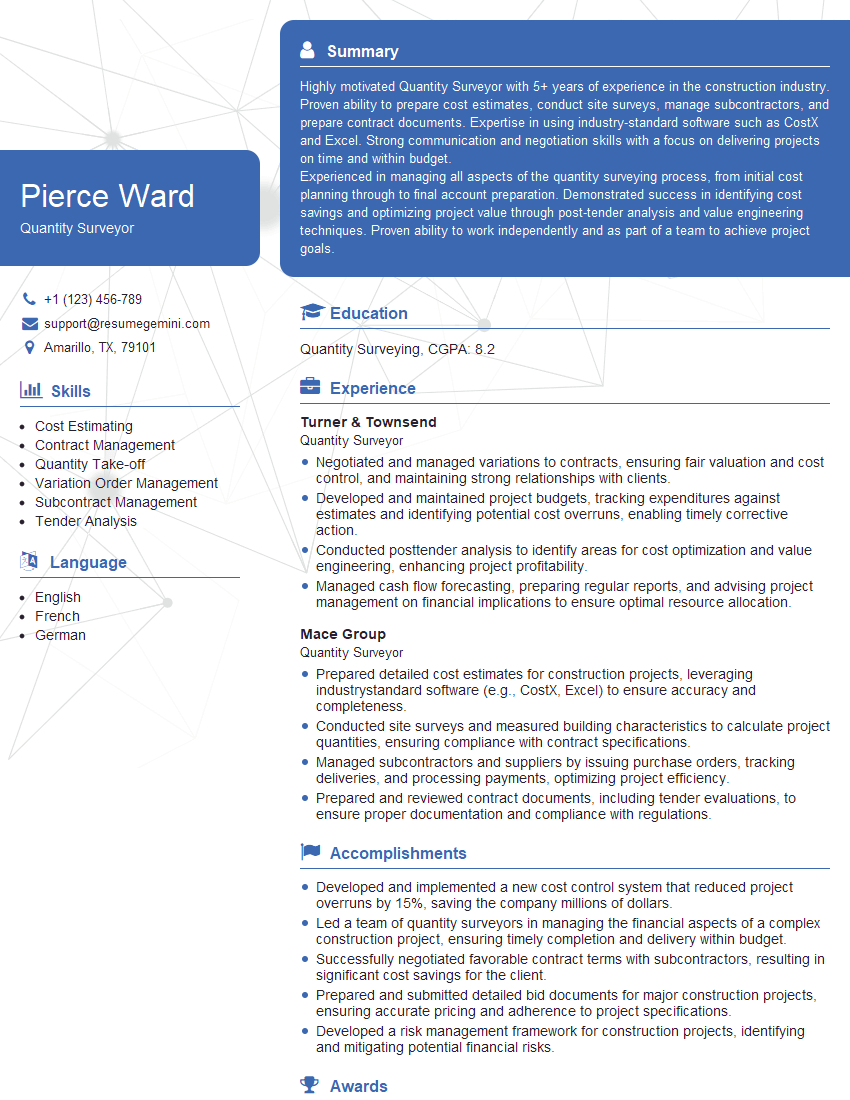Preparation is the key to success in any interview. In this post, we’ll explore crucial Bidding and Estimation interview questions and equip you with strategies to craft impactful answers. Whether you’re a beginner or a pro, these tips will elevate your preparation.
Questions Asked in Bidding and Estimation Interview
Q 1. Explain the difference between top-down and bottom-up estimating.
Top-down and bottom-up estimating are two fundamentally different approaches to determining the cost of a project. Think of it like building a house: top-down starts with the overall blueprint and cost, while bottom-up meticulously calculates the cost of each brick.
Top-down estimating begins with a high-level overview of the project. It uses historical data, analogous projects, or expert judgment to estimate the total cost. This method is quick and useful for early-stage planning or when detailed information is unavailable. However, it can be less accurate, potentially missing crucial details.
Bottom-up estimating involves a detailed breakdown of the project into individual work packages or tasks. Each component is estimated separately, and these individual cost estimates are then aggregated to arrive at the total project cost. This is more accurate but significantly more time-consuming. It’s perfect for projects demanding high precision.
Example: Imagine estimating the cost of a software development project. A top-down approach might use a similar project’s cost as a starting point, adjusting for differences in scope. A bottom-up approach would estimate the cost of each development phase (design, coding, testing), each task within those phases, and then sum those costs.
Q 2. Describe your experience with different estimating methods (e.g., parametric, unit price, detailed).
My experience spans a variety of estimating methods. I’ve extensively used parametric, unit price, and detailed estimating approaches, adapting my choice to the project’s complexity and available data.
- Parametric Estimating: This uses statistical relationships between historical project data (e.g., square footage and construction cost) to estimate the cost of a new project. It’s efficient for similar projects, but its accuracy depends on the reliability of the historical data and the project’s similarity to past ones. I used this successfully when estimating the cost of a series of similar website redesigns.
- Unit Price Estimating: This method involves breaking down the project into individual units (e.g., number of hours for a task, square meters of flooring), assigning a price per unit, and multiplying to get the total cost. It’s suitable when there’s a clear understanding of work units and their associated costs. This is common in construction and manufacturing. For instance, I leveraged this when estimating the cost of a highway paving project.
- Detailed Estimating: This involves meticulously analyzing each aspect of the project, creating a detailed work breakdown structure (WBS) and estimating the cost of each task, including materials, labor, and overhead. It’s the most accurate but also the most time-consuming. I employed this approach for a large-scale infrastructure project where accuracy was paramount.
Q 3. How do you handle risk and uncertainty in your estimations?
Risk and uncertainty are inherent in any estimation. I address them using a combination of techniques:
- Risk identification and analysis: I systematically identify potential risks (e.g., material price fluctuations, delays due to weather) and analyze their likelihood and potential impact. This usually involves brainstorming sessions and reviewing historical project data.
- Contingency planning: I incorporate contingency reserves into my estimates to account for unforeseen events. The size of the reserve depends on the assessed level of risk. For higher-risk projects, I’ll allocate a larger contingency.
- Sensitivity analysis: I perform sensitivity analysis to assess how changes in key variables (e.g., labor rates, material costs) impact the overall estimate. This helps understand which risks are most critical and prioritize mitigation efforts.
- Monte Carlo simulation: For complex projects with numerous uncertainties, I may utilize Monte Carlo simulation. This statistical technique simulates multiple scenarios to generate a probability distribution of possible outcomes, giving a more comprehensive understanding of the potential cost range.
For example, when estimating a construction project in a region prone to flooding, I would incorporate a contingency for potential weather-related delays and damage repairs.
Q 4. What software or tools are you proficient in for bidding and estimating?
I’m proficient in several software tools for bidding and estimating. My expertise includes:
- Primavera P6: For scheduling and cost control, particularly in large-scale projects.
- Microsoft Project: For project scheduling and resource allocation.
- EstimateOne: A powerful estimating software extensively used in construction.
- Excel: While seemingly simple, Excel remains a crucial tool for data analysis, creating cost models, and presenting estimates.
I’m also comfortable using various specialized software based on project needs. My ability extends beyond just using the software; I understand the underlying principles and can adapt these tools to different project contexts.
Q 5. Explain your process for developing a detailed bid proposal.
Developing a detailed bid proposal is a systematic process:
- Project understanding: Thoroughly reviewing the project scope, specifications, drawings, and any other relevant documentation.
- Cost estimation: Employing the appropriate estimating method (parametric, unit price, or detailed) to determine the project cost, including materials, labor, equipment, and overhead.
- Risk assessment: Identifying and analyzing potential risks and incorporating contingency reserves.
- Schedule development: Creating a realistic project schedule, outlining key milestones and deadlines.
- Proposal writing: Preparing a clear and concise proposal, outlining the project approach, methodology, schedule, cost breakdown, and any assumptions or limitations.
- Review and submission: Thoroughly reviewing the proposal for accuracy and completeness before submitting it to the client.
Throughout this process, I focus on clear communication, ensuring the client understands the proposed approach and the basis for my cost estimate. The goal is to build trust and demonstrate our expertise.
Q 6. How do you identify and mitigate potential cost overruns?
Cost overruns are a major concern. My approach to mitigation involves:
- Accurate estimating: Using appropriate methods and investing sufficient time in the estimation phase. This includes thorough data gathering and consideration of all potential costs.
- Regular monitoring and control: Implementing a robust cost control system with regular progress reports, comparing actual costs against the budget, and investigating any variances.
- Change management: Establishing a formal process for managing changes in scope, ensuring that any changes are properly documented, evaluated, and approved before affecting the budget.
- Value engineering: Identifying opportunities to improve project efficiency and reduce costs without sacrificing quality. This could involve exploring alternative materials or construction methods.
- Effective communication: Maintaining open communication with the client and project team to identify potential problems early and address them proactively.
For instance, on a recent construction project, by regularly monitoring progress and proactively addressing minor delays through improved coordination, we prevented a potential cost overrun caused by schedule slippage.
Q 7. Describe a time you had to make a critical decision under pressure during the bidding process.
During a particularly tight bid for a large-scale renovation project, we faced a last-minute change in the scope. The client unexpectedly added a significant feature requiring additional labor and materials, just hours before the deadline. Our initial estimate wouldn’t cover this.
Under significant pressure, I had to quickly assess the impact of this change. I brought together the team to determine the most efficient and cost-effective solution, prioritizing essential elements while making calculated compromises on non-critical aspects. We re-evaluated our estimate and swiftly prepared a revised proposal that addressed the added scope while remaining competitive. While it involved late nights, this fast-paced decision resulted in securing the project. It underscored the importance of adaptable thinking and team collaboration under pressure in a high-stakes situation. This successful outcome reinforced the importance of thorough planning coupled with flexibility.
Q 8. How do you prioritize tasks and manage time effectively during a bid preparation?
Prioritizing tasks and managing time effectively during bid preparation is crucial for success. It’s like running a marathon, not a sprint. I use a combination of techniques to stay organized and on schedule. First, I carefully review the RFP (Request for Proposal) to identify key deadlines and deliverables. Then, I break down the entire process into smaller, manageable tasks, assigning each a realistic timeframe. This allows for better tracking of progress and identification of potential bottlenecks early on. I employ tools like Gantt charts or project management software to visualize the timeline and dependencies between tasks. Prioritization follows a weighted approach, focusing on tasks with the highest impact on the bid’s success and those with the earliest deadlines. For example, if a technical proposal is due sooner than the cost proposal, I allocate more time to the technical aspect initially. Regular progress checks and adjustments to the schedule, based on the actual work completed, prevent slippage and keep the project on track.
I also use the Pareto Principle (80/20 rule) – identifying the 20% of tasks that contribute to 80% of the outcome – to focus my efforts efficiently. Delegation, where appropriate, is another crucial aspect. This frees up my time to concentrate on high-value activities, ensuring maximum productivity.
Q 9. Explain your understanding of contingency planning in bidding and estimation.
Contingency planning in bidding and estimation is all about anticipating and mitigating potential risks that could impact the project’s timeline or budget. Think of it as building a safety net. It involves identifying potential problems – such as material price fluctuations, unexpected delays, or changes in scope – and developing strategies to address them. This could include adding a contingency buffer (a percentage added to the estimated cost) to account for unforeseen expenses or establishing clear escalation procedures to manage changes. A strong contingency plan includes detailed risk assessments, outlining the likelihood and potential impact of each identified risk. Then, for each risk, I define mitigation strategies, including alternative solutions and fallback plans. For instance, if a specific material is at risk of delay, I might identify an alternative supplier or a substitute material. Thorough documentation of all risks, mitigation strategies, and contingency plans is crucial for transparent communication with the client and internal stakeholders.
Q 10. How do you ensure accuracy and consistency in your cost estimations?
Ensuring accuracy and consistency in cost estimations requires a meticulous and methodical approach. I rely on a combination of proven techniques and tools to minimize errors. First, a detailed breakdown of all project costs is essential. This includes direct costs (materials, labor, equipment) and indirect costs (overhead, permits, insurance). I use standardized cost databases and historical data from past projects, adjusted for inflation and current market conditions, to obtain accurate cost estimates for materials and labor. Software tools, like specialized estimation programs, assist in streamlining the process and performing calculations efficiently, reducing the risk of human error. Regular checks and reviews by peers are also critical in ensuring accuracy. This peer review process serves as a second line of defense, identifying any potential omissions or inconsistencies.
Consistency is achieved through using a standardized estimation methodology across all projects. This methodology clearly defines the processes and procedures to be followed, ensuring a uniform approach regardless of the project’s specifics. Regular training and updates for team members also contribute to maintaining consistency in estimating practices. Documentation of the estimation process, including assumptions, calculations, and justifications, provides transparency and allows for easy auditing and error tracking.
Q 11. What are the key factors you consider when analyzing a request for proposal (RFP)?
Analyzing a Request for Proposal (RFP) is the first and arguably most important step in the bidding process. It’s like understanding the rules of the game before you start playing. My analysis involves several key factors. First, I thoroughly review the scope of work, identifying all requirements, deliverables, and specifications. This includes paying close attention to any ambiguities or unclear instructions. Next, I assess the client’s needs and expectations, trying to understand their priorities and preferences. I then evaluate the timeline, identifying key milestones and deadlines. The evaluation criteria outlined in the RFP receive careful consideration, as these are the metrics against which my bid will be judged. Finally, I analyze the contractual terms and conditions, paying attention to payment schedules, liability clauses, and other legal aspects. A thorough understanding of all these factors helps me develop a competitive and compliant bid that addresses the client’s needs while protecting my company’s interests.
Q 12. How do you handle changes in scope or requirements during the bidding process?
Handling changes in scope or requirements during the bidding process requires a structured and proactive approach. It’s important to have a clear change management process established from the outset. As soon as a change request is received, I document it thoroughly, clearly outlining the nature of the change and its potential impact on the project timeline and budget. I then communicate the change request to all relevant stakeholders, including the client and my team. Before accepting any changes, a detailed cost-benefit analysis is conducted. This analysis quantifies the additional costs and time associated with the change, and these costs are then presented to the client in a formal change order. This formal process ensures that both the client and our company are on the same page regarding the financial implications of any modifications. The change order is signed and approved by both parties before implementing the change. This methodical approach prevents misunderstandings and keeps the project on track while safeguarding our financial position.
Q 13. Describe your experience with value engineering and cost optimization.
Value engineering and cost optimization are crucial skills in bidding and estimation, focusing on delivering the required functionality at the lowest possible cost. Value engineering is about improving the value of a project without necessarily increasing its cost. It involves scrutinizing each aspect of the design and construction to identify areas where cost reductions can be achieved without compromising quality or functionality. For example, using alternative materials or construction methods, streamlining processes, or optimizing designs. Cost optimization, on the other hand, is about finding the most cost-effective solution among several options that meet the required specifications. My experience involves applying value engineering techniques throughout the estimation process, identifying opportunities to reduce costs without sacrificing performance. For instance, I might suggest using prefabricated components instead of on-site construction, leading to faster construction and labor cost savings. This also involves using innovative technologies and materials to achieve efficiency gains. Detailed cost-benefit analysis is employed to ensure that any cost-saving measures also improve overall project value.
Q 14. How do you manage and track multiple bids simultaneously?
Managing and tracking multiple bids simultaneously requires a highly organized and systematic approach. I employ project management tools and techniques to keep everything under control. First, I create a centralized repository for all bid-related documents, using a shared drive or project management software. This ensures easy access to all necessary information for all team members. I then establish a clear timeline for each bid, outlining key milestones and deadlines. This is typically done using a Gantt chart or a similar visual scheduling tool. Each bid is assigned a unique identifier, allowing for easy tracking and reporting. Regular progress meetings are held to review the status of each bid and address any challenges or roadblocks. Detailed documentation of all activities, decisions, and communication is essential. This documentation serves as an audit trail, ensuring transparency and accountability. I also prioritize tasks and allocate resources effectively across different bids, ensuring that each bid receives the necessary attention without compromising the overall efficiency.
Q 15. How do you present your estimations to clients or stakeholders?
Presenting estimations effectively involves more than just presenting numbers; it’s about building trust and ensuring clients understand the rationale behind the figures. My approach is to present a clear, concise, and visually appealing report. This typically begins with a summary of the total estimated cost, highlighting key milestones and potential risks. I then break down the estimate into detailed cost categories, explaining each item and its associated cost drivers. For instance, for a software development project, this might include labor costs (broken down by role and hours), material costs (software licenses, hardware), and contingency for unforeseen issues.
I use visual aids like charts and graphs to make complex data more digestible. A bar chart comparing different cost components or a timeline illustrating project phases and their associated costs can significantly enhance understanding. Finally, I always leave time for a Q&A session to address any client concerns or questions. I find that a collaborative approach, where clients feel involved in the process, is key to securing buy-in and building strong working relationships.
For example, in a recent project involving the construction of a new warehouse, I presented a detailed breakdown of material costs, labor hours, equipment rental, and permits, visually supported by a Gantt chart showing project timelines. This allowed the client to easily see the breakdown of costs and understand the projected timeline, which resulted in a smoother approval process.
Career Expert Tips:
- Ace those interviews! Prepare effectively by reviewing the Top 50 Most Common Interview Questions on ResumeGemini.
- Navigate your job search with confidence! Explore a wide range of Career Tips on ResumeGemini. Learn about common challenges and recommendations to overcome them.
- Craft the perfect resume! Master the Art of Resume Writing with ResumeGemini’s guide. Showcase your unique qualifications and achievements effectively.
- Don’t miss out on holiday savings! Build your dream resume with ResumeGemini’s ATS optimized templates.
Q 16. Describe your experience with different types of contracts (e.g., fixed-price, cost-plus).
My experience spans various contract types, each with its own advantages and disadvantages. Fixed-price contracts offer certainty for both the client and contractor, establishing a predetermined cost regardless of actual expenses. However, they require meticulous upfront planning and risk assessment, as unforeseen changes can impact profitability. I’ve successfully managed numerous fixed-price projects by employing detailed scope definitions, rigorous change management processes, and meticulous risk mitigation strategies.
Cost-plus contracts, on the other hand, involve the client reimbursing the contractor for actual costs incurred, plus a predetermined fee or percentage. This approach is better suited for projects with uncertain scope or rapidly evolving requirements, offering greater flexibility. My experience includes negotiating cost-plus contracts that incorporate clear cost accounting procedures and regular progress reports to maintain transparency and avoid disputes. I’ve found that detailed cost tracking and regular client communication are vital for success in these contracts. I carefully define allowable costs and what constitutes ‘reasonable’ expenses to prevent cost overruns.
Finally, I also have experience with Time and Materials (T&M) contracts, a type of cost-plus contract best for projects where the scope is unclear or likely to change frequently. Here, accurate tracking of time spent and materials used is critical. Understanding the nuances of each contract type and adapting my estimation and management techniques accordingly has been crucial to my success.
Q 17. How do you negotiate with subcontractors and suppliers?
Negotiating with subcontractors and suppliers requires a balanced approach, combining collaboration and firm negotiation. I start by establishing a clear and detailed scope of work, including specifications, deliverables, and timelines. I then obtain multiple bids, comparing price, quality, and experience. I don’t always choose the lowest bidder; factors like reputation, reliability, and capacity are also crucial. The negotiation process focuses on finding a win-win solution. I try to build rapport, explaining project requirements and my expectations. This transparent approach often leads to more collaborative relationships and mutually beneficial agreements.
For example, during a recent project, a subcontractor initially bid significantly higher than expected. Instead of simply rejecting the bid, I explored the reasons for the higher cost. We discovered that their understanding of the scope was incomplete. By clarifying the requirements and offering a more precise scope definition, we reached a mutually acceptable price that ensured both parties’ interests were met. I always ensure that contracts with subcontractors include clear payment terms, dispute resolution mechanisms, and performance standards to ensure smooth collaboration throughout the project.
Q 18. How do you ensure compliance with relevant regulations and standards in your estimations?
Ensuring regulatory compliance is paramount in bidding and estimation. My process involves a thorough review of all relevant laws, regulations, and industry standards applicable to each project. This includes environmental regulations, building codes, safety standards, and labor laws. I incorporate these requirements into the estimation process from the outset, accounting for associated costs such as permits, inspections, and specialized materials or labor. For example, if a project involves working near a protected wetland, I’ll factor in the costs associated with environmental impact assessments and mitigation measures required by local authorities.
I maintain updated records of all permits, licenses, and approvals obtained throughout the project. Regular reviews of our processes and procedures help keep us updated on any changes in regulations, ensuring continuous compliance. I often consult with legal and technical experts to ensure complete compliance and to address any ambiguities or uncertainties.
Q 19. How do you handle disagreements or conflicts related to cost estimations?
Disagreements regarding cost estimations are inevitable. My approach focuses on proactive communication and collaborative problem-solving. I always clearly document all assumptions, calculations, and justifications used in my estimations. This provides a transparent record that can be reviewed and discussed if discrepancies arise. I encourage open dialogue with stakeholders, listening to their concerns and addressing them directly. If a disagreement persists, I suggest using a structured approach, such as facilitated negotiation or mediation, to reach a mutually agreeable solution.
For instance, in one project, the client challenged a particular cost element. Rather than getting defensive, I presented them with the detailed documentation backing up my estimate, clarifying the rationale behind each cost component. This transparent approach allowed us to identify a misunderstanding about the scope of work, resolving the conflict amicably.
Q 20. How do you measure the success of your bidding and estimation efforts?
Measuring the success of bidding and estimation efforts involves both quantitative and qualitative metrics. Quantitatively, I track metrics such as win rate (the percentage of bids won), the accuracy of cost estimations (comparing estimated costs to actual costs), and the project profitability (the difference between revenue and total costs). A low win rate might indicate issues with pricing or proposal quality, while significant cost overruns point to deficiencies in the estimation process.
Qualitatively, I assess client satisfaction through feedback surveys and post-project reviews. This provides insights into the effectiveness of communication, the clarity of estimations, and overall client experience. A key indicator of success is the establishment of strong, long-term relationships with clients, based on trust and transparency. Regularly analyzing these metrics helps identify areas for improvement and refine our bidding and estimation strategies.
Q 21. What are your strategies for improving the accuracy of your estimations over time?
Continuously improving estimation accuracy is an ongoing process. One key strategy is to regularly review past projects, comparing estimated costs to actual costs. This helps identify recurring errors or biases in our estimation process. For example, if we consistently underestimate the time required for a particular task, we can adjust our estimation methodologies to account for this. I also emphasize ongoing training and development for our team, keeping abreast of the latest estimation techniques, software, and industry best practices.
Another crucial strategy involves leveraging historical data and developing more robust cost databases. By meticulously tracking cost data from past projects, we can create detailed cost models that improve the accuracy of future estimations. The use of estimation software that incorporates machine learning algorithms can automate some aspects of the process and improve prediction accuracy over time. Regularly soliciting feedback from the team and stakeholders also helps identify areas of improvement and refine our estimation process for greater accuracy and efficiency.
Q 22. Explain your understanding of Earned Value Management (EVM).
Earned Value Management (EVM) is a project management technique for measuring project performance and progress. It integrates scope, schedule, and cost to provide a comprehensive view of project health. Essentially, it compares planned work to actual work, allowing for early identification of variances and potential problems.
EVM uses three key metrics:
- Planned Value (PV): The budgeted cost of work scheduled to be completed at a specific point in time.
- Earned Value (EV): The value of work actually completed at a specific point in time. This is often calculated based on a pre-defined system like percent complete or milestones achieved.
- Actual Cost (AC): The actual cost incurred to complete the work up to a specific point in time.
By comparing PV, EV, and AC, we can calculate key performance indicators (KPIs) like Schedule Variance (SV = EV – PV), Cost Variance (CV = EV – AC), Schedule Performance Index (SPI = EV/PV), and Cost Performance Index (CPI = EV/AC). These indicators highlight whether the project is on schedule, within budget, and if corrective actions are needed.
For example, if a project has a PV of $10,000 at a certain point, an EV of $8,000, and an AC of $9,000, it indicates the project is behind schedule (SV = -$2,000) and over budget (CV = -$1,000).
Q 23. Describe your experience with using Earned Value Management (EVM) in project control and estimation.
In my previous role at [Previous Company Name], we extensively used EVM for all major projects. We employed a custom EVM system integrated with our project management software. This allowed us to track progress in real-time, automatically calculating key metrics and generating reports. I was responsible for:
- Defining the Work Breakdown Structure (WBS) and assigning costs to each task to establish the baseline PV.
- Developing and implementing a system for measuring earned value, using a combination of percent complete and milestone completion.
- Regularly monitoring AC and comparing it to EV and PV to identify variances and potential risks.
- Presenting regular reports to stakeholders, highlighting performance against the baseline and proposing corrective actions where necessary.
- Using EVM data to forecast project completion dates and costs, and to revise estimates as the project progressed.
For instance, on a recent infrastructure project, early EVM analysis revealed a cost overrun on a specific subsystem. By analyzing the CPI and SPI, we were able to pinpoint the source of the problem – inefficient resource allocation – and implement corrective measures, ultimately bringing the project back on track.
Q 24. How do you utilize historical data to improve future estimations?
Historical data is invaluable for improving future estimations. I use a multi-step process:
- Data Collection & Cleaning: I gather data from past projects, including actual costs, durations, resource utilization, and any relevant contextual information. This data is then cleaned and standardized to ensure consistency and accuracy.
- Analysis & Pattern Identification: I analyze the cleaned data to identify trends, patterns, and correlations. This might involve statistical analysis, identifying common causes of cost overruns or schedule delays, and understanding the impact of different factors on project performance.
- Develop Parametric Models: Based on the identified patterns, I develop parametric models or algorithms that predict future project costs and durations based on key project characteristics. For example, a model might estimate the cost of a software project based on its size (lines of code) and complexity.
- Calibration & Validation: These models are then calibrated and validated using additional data points. This ensures the models accurately reflect reality and minimize prediction errors. Regular review and updates are crucial for maintaining model accuracy.
- Integration into Estimation Process: Finally, the refined models and historical data are integrated into the estimation process for future projects, informing better cost and schedule estimates. This makes the process more efficient and accurate.
For example, if historical data shows a consistent relationship between the number of team members and the project completion time, that relationship can be incorporated into future estimations.
Q 25. What are some common mistakes to avoid in bidding and estimation?
Several common mistakes can derail bidding and estimation processes:
- Underestimating Risks and Contingencies: Failing to adequately account for potential risks and unforeseen circumstances can lead to significant cost overruns and delays. Always build a healthy contingency into your estimates.
- Inaccurate Scope Definition: A poorly defined scope is a recipe for disaster. Ambiguity and incomplete specifications can result in misinterpretations, leading to rework and cost overruns. Detailed scope definition is essential.
- Ignoring Historical Data: Not leveraging past project data to inform current estimations can lead to unrealistic targets and poor performance predictions. Learn from past experiences!
- Lack of Team Input: Failing to involve the project team in the estimation process can lead to unrealistic estimates and a lack of buy-in. All relevant stakeholders should provide input.
- Unrealistic Schedules: Overly aggressive schedules often lead to compromises in quality and increase the risk of failure. Schedules should be realistic and achievable.
- Poor Communication: A lack of clear communication with clients regarding assumptions and limitations of the estimate can lead to misunderstandings and disputes later on.
A crucial aspect is to always be transparent about the estimations, clearly explaining the assumptions and limitations and clearly communicating potential risks to stakeholders.
Q 26. Describe your process for reviewing and validating cost estimates.
My process for reviewing and validating cost estimates involves a multi-layered approach:
- Independent Review: The initial cost estimate is reviewed by an independent estimator or team to identify potential errors or omissions. This provides a fresh perspective and identifies any biases.
- Bottom-Up Verification: The estimate is broken down into its constituent components, and each component’s cost is verified using detailed cost analyses and market research.
- Top-Down Validation: A top-down analysis is also performed to compare the estimate to industry benchmarks and similar projects to ensure its reasonableness.
- Sensitivity Analysis: A sensitivity analysis is carried out to understand the impact of potential changes in key variables on the overall cost estimate. This helps to determine the range of possible outcomes.
- Documentation: The entire review process is meticulously documented, including all assumptions, justifications, and any revisions made to the initial estimate.
- Stakeholder Approval: The validated estimate is then presented to stakeholders for approval. Any questions or concerns are addressed, and the estimate is formally approved before proceeding with the project.
This rigorous review process ensures that the final estimate is accurate, complete, and realistic, minimizing the risk of cost overruns and improving decision-making.
Q 27. How do you incorporate lessons learned from past projects into your future estimations?
Lessons learned from past projects are crucial for improving future estimations. I maintain a dedicated repository where I document key insights, including:
- Cost Variances: Detailed analysis of cost variances, identifying the root causes of overruns or underruns.
- Schedule Variances: Similarly, detailed analysis of schedule variances, identifying factors affecting project timelines.
- Risk Assessments: Documentation of identified risks and their actual impact on the project.
- Process Improvements: Recommendations for improvements in processes and methodologies based on past project experiences.
- Successful Strategies: Identification of successful strategies and techniques that can be replicated in future projects.
This repository is regularly reviewed and updated, and its content is used to refine estimation techniques, improve risk management, and ensure more realistic and accurate future estimates. For example, if a past project experienced delays due to inadequate resource allocation, that lesson informs the resource planning for future projects, leading to more accurate scheduling and cost estimates.
Q 28. How do you stay current with industry trends and best practices in bidding and estimation?
Staying current with industry trends and best practices is essential. I use a variety of methods:
- Professional Organizations: Active membership in professional organizations like the Project Management Institute (PMI) provides access to resources, training, and networking opportunities.
- Industry Publications & Journals: Regularly reading industry publications and journals keeps me updated on the latest research, methodologies, and technological advancements.
- Conferences & Workshops: Attending industry conferences and workshops provides valuable insights and allows me to network with other professionals.
- Online Courses & Webinars: Utilizing online platforms for continuous learning helps me stay abreast of new techniques and tools.
- Mentorship & Networking: Connecting with experienced professionals through mentorship and networking opportunities expands my knowledge and exposes me to different perspectives.
By actively seeking out new information and engaging with the professional community, I can ensure that my estimation techniques remain cutting-edge and my knowledge base remains current, leading to more efficient and accurate project estimations.
Key Topics to Learn for Bidding and Estimation Interview
- Cost Estimation Techniques: Understanding different methods like parametric estimating, bottom-up estimating, and analogous estimating, their strengths, weaknesses, and appropriate applications.
- Risk Assessment and Mitigation: Identifying potential risks in a project, quantifying their impact, and developing strategies to mitigate those risks within the bidding process. Practical application: Building contingency plans into your estimates.
- Profit Margin Analysis: Determining appropriate profit margins based on market conditions, competitor analysis, and project complexity. Consider factors influencing profitability.
- Proposal Writing and Presentation: Structuring a compelling bid proposal, clearly articulating the value proposition, and effectively presenting your estimates to clients. This includes understanding the importance of clear and concise communication.
- Contract Negotiation: Understanding different contract types (fixed-price, time & materials, etc.) and negotiating favorable terms while protecting your company’s interests.
- Software and Tools: Familiarity with commonly used software for bidding and estimation (mention general categories rather than specific software names to maintain broad applicability).
- Data Analysis and Interpretation: Using historical data to inform future estimates, identifying trends, and making data-driven decisions.
- Resource Allocation and Scheduling: Effectively allocating resources (labor, materials, equipment) to ensure project completion within the estimated timeframe and budget.
Next Steps
Mastering bidding and estimation is crucial for career advancement in many industries, opening doors to senior roles with increased responsibility and earning potential. A strong understanding of these principles demonstrates valuable skills to potential employers.
To significantly increase your chances of landing your dream job, create an ATS-friendly resume that highlights your key accomplishments and skills. ResumeGemini is a trusted resource that can help you build a professional and impactful resume tailored to the specific requirements of bidding and estimation roles. Examples of resumes optimized for this field are available to guide your creation process. Invest the time to craft a compelling resume – it’s your first impression with potential employers.
Explore more articles
Users Rating of Our Blogs
Share Your Experience
We value your feedback! Please rate our content and share your thoughts (optional).
What Readers Say About Our Blog
Hello,
We found issues with your domain’s email setup that may be sending your messages to spam or blocking them completely. InboxShield Mini shows you how to fix it in minutes — no tech skills required.
Scan your domain now for details: https://inboxshield-mini.com/
— Adam @ InboxShield Mini
Reply STOP to unsubscribe
Hi, are you owner of interviewgemini.com? What if I told you I could help you find extra time in your schedule, reconnect with leads you didn’t even realize you missed, and bring in more “I want to work with you” conversations, without increasing your ad spend or hiring a full-time employee?
All with a flexible, budget-friendly service that could easily pay for itself. Sounds good?
Would it be nice to jump on a quick 10-minute call so I can show you exactly how we make this work?
Best,
Hapei
Marketing Director
Hey, I know you’re the owner of interviewgemini.com. I’ll be quick.
Fundraising for your business is tough and time-consuming. We make it easier by guaranteeing two private investor meetings each month, for six months. No demos, no pitch events – just direct introductions to active investors matched to your startup.
If youR17;re raising, this could help you build real momentum. Want me to send more info?
Hi, I represent an SEO company that specialises in getting you AI citations and higher rankings on Google. I’d like to offer you a 100% free SEO audit for your website. Would you be interested?
Hi, I represent an SEO company that specialises in getting you AI citations and higher rankings on Google. I’d like to offer you a 100% free SEO audit for your website. Would you be interested?
good

